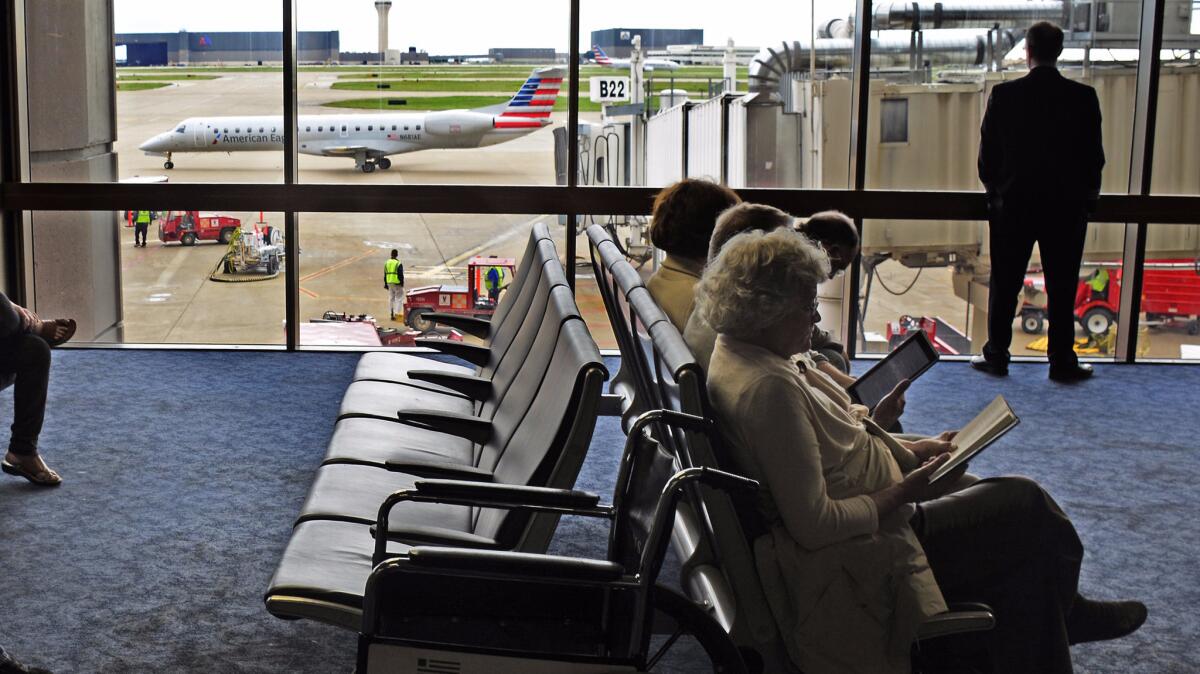Regional jets, as tiny and as cramped as they are, do fill a vital role for airlines and travelers

- Share via
Question: My wife and I have recently traveled several times from the East Coast and the Midwest to Southern California. On at least four of these flights, we have been stuck in small regional jets. The flights have at times lasted three hours and are cramped and hard on the back, and the planes have limited restroom facilities. Apparently these small planes are wonderful for the airlines’ bottom lines. Have travelers responded to this behavior by the airlines?
Hans Palmer
Claremont
Answer: Google “I hate regional jets,” and you’ll find that Palmer has plenty of company.
The good news: The turbo props that used to provide domestic regional service have mostly gone the way of the dodo.
Then 50-seat jets became the norm even though they’re cramped and not terribly fuel efficient.
Meanwhile, more good news, said Seth Kaplan, managing partner of Airline Weekly, for “anybody who hates 50-seat jets: They’re not being manufactured anymore.
“The airlines are not being generous,” he added. “The economics were such that … [airlines] are generally retiring them.”
That doesn’t change this fact, which sounds like a no-duh, although the statistics don’t necessarily bear this out. Regional jets — or RJs, as they’re called — even the larger 76-seaters, aren’t an Airbus.
Overhead storage is so limited that you’ll probably have to gate-check your carry-on bag. I can stand up straight in one, but if you’re more than 6 feet tall, you’ll have to hunch over to walk down the aisle. Wi-Fi isn’t a norm.
I speak from recent experience. Last week, I flew from LAX to Wichita, Kan., and home on American. My elation at flying an A321 to and from Dallas turned to dismay when I read this line on my reservation: The Wichita segment would be “operated by Mesa Airlines as American Eagle.” Mesa is a regional carrier for American.
I was on a Bombardier CRJ900, where the hip room is 17.3 inches and the pitch (which Seat Guru defines as “ the distance from any point on one seat to the exact same point on the seat in front or behind”) is 31 inches, according to that website’s seat maps. The pitch is the same as the A321, and I have only .7 of an inch less hip room, although, at a certain age, that becomes more important, thank you very much.
The RJ flight was fine, to my surprise. My seatmate, who said she stands 5 feet 1 inch, smacked her head as she took her seat but attributed it to klutziness. The flight arrived on time, and I could hear myself think.
Here’s what I was thinking: I’m a whiner who wants everything, including schedules when I want them and the conveniences of a larger aircraft.
But we don’t get to have it both ways. At least, not for now.
Regional jet travel continues to grow as business travelers ask for more flexible schedules, and airlines realize that it can be less expensive to use a regional jet than one of the big jets, where empty seats represent lost revenue.
It’s not Palmer’s imagination that regional jet travel has grown. Citing Department of Transportation data, the Wall Street Journal’s Scott McCartney wrote in 2013, “Passenger traffic on RJs … has more than tripled since 2000.” Flights last longer too, McCartney noted, citing stats from the Regional Airline Assn.
About 10% of flights at LAX and nearly a quarter at Burbank and Ontario are regional jets, said Kaplan, who is also the co-author of “Glory Lost and Found: How Delta Climbed From Despair to Dominance in the Post-9/11 Era.” He cited Diio Mi data for those stats as well as numbers that show Orange County’s John Wayne has only 4% regional service, thanks to lots of flights by Southwest, which isn’t built on regional jet use, and some capacity constraint at the airport.
As airline profitability improves, bigger jets may increasingly take over for their smaller kin on some routes, known as “upgauging,” Kaplan said. But don’t count out the smaller craft.
“Airlines are still quite happy with 76-seat jets for a lot of missions,” Kaplan said in a later email.
If it weren’t for the smaller jets, Kaplan said, some rural areas would have no airline service.
And that would be something to complain about.
Have a travel dilemma? Write to travel@latimes.com. We regret we cannot answer every inquiry.
Sign up for The Wild
We’ll help you find the best places to hike, bike and run, as well as the perfect silent spots for meditation and yoga.
You may occasionally receive promotional content from the Los Angeles Times.




